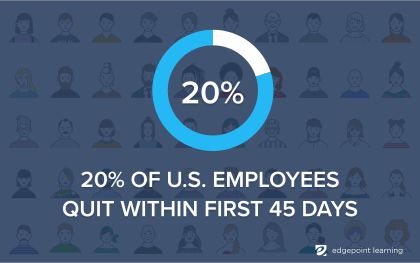What's The Real Cost of Training New Employees?
Michael Hansen
🍿 6 min. read
Consider this: for an investment of just 10% of an employee’s salary (or less!), you can help create employees who excel in their work and are invested in the success of your company. The cost of training new employees provides a significant ROI and protects the health of your bottom line. Here's how to determine the real cost of training new employees in your workforce.
How much does it cost to train new employees?
According to the 2017 Training industry report, companies spent an average of $1,075 per employee trained. While this may seem like small potatoes, this is a $200 increase from the previous year. This translates, in cash dollars, to a nearly 33% increase in overall training expenditures in the U.S. from 2016 to 2017 for a total of nearly 91 billion dollars.

Training costs include the actual materials created or utilized for training and time spent in each training module or conference. This is calculated into the total because every moment an employee spends in training is time away from their job. While training is crucial for your employees and the success of your business, it does take employees out of the mix for a period of time.
What are the hidden costs of training a new employee?
The training cost per employee formula used in the report above does not necessarily calculate the true cost of training new employees. Without diligent attention, hidden costs can add up.
Potential hidden costs of training new employees include:
- Administrative and onboarding paperwork time: Filling out forms for benefits, taxes, and insurance ties up new employees and HR staff
- Premature turnover: This occurs when an employee is trained and then leaves a job in six months or less
- Low productivity during training: It stands to reason that an employee will be less productive when they are still learning how to do their job
- Supplies for new employees: This can be a major expense if your company supplies employees with a full office of products that include printers, laptops, and other basic supplies
- Manager attention: New employees often need more attention from managers, which takes higher-paid managers away from their other work
Many of these hidden expenses can be mediated with high-quality employee training, but some (e.g. manager supervision and supplies for new employees) are just the cost of doing business.
What are the risks of not training new employees?
Poorly trained employees are just not as good at their jobs. This makes employees unhappy, lowers customer satisfaction, and eventually leads to conflicts that could have been prevented. This all makes sense, however, these aren't the largest risks of neglecting to add a formal new employee training program. What is? The high cost of employee turnover.
Digital training options along with on-the-job training allows your new employees to become more settled in their jobs—and happier employees can lead to an increase in your retention rates. Up to 20% of employees in the U.S quit within 45 days of being hired for a job. That number increases to as much as 50% when it comes to retail employees!
A turnover can end up costing your company 16-20% of your employee’s annual salary. As employees move up the ladder, this cost can skyrocket, with managerial level training budgets hovering right around $188,000 for larger companies.

Imagine nearly $200,000 walking out the door annually. That’s the risk of not training your new employees.
Making the cost of training new employees effective
Making the best use of employee and company training time and money is the key to your new employee training effective and manageable. Here are four strategies to reduce the cost of training new employees while still giving your employees the tools they need to succeed:
- Create repeatable and scalable onboarding programs
- Use on-the-job training
- Implement microlearning tools
- Create better training, faster
- Consider outsourcing your training development
1. Create repeatable and scalable onboarding programs
If you have to continuously create new onboarding programs for each new hire that adds up fast.
Create repeatable programs that cover the basics that every employee needs to know, offering specialized training only to those who need it. Use checklists of employee procedures to create a record of training, and make sure all managers know what steps to take (and in what order!).
2. Use on-the-job training
Relevant, targeted, and timely on the job training can be an incredible training tool that brings the cost of training new employees down.
Because this type of training is specialized and focused on the specific tasks they'll performs, employees can immediately see the value of the information. This means better employee engagement with increased flexibility and an efficient use of company time (and training dollars!).
3. Implement microlearning tools
Microlearning is a cost-effective type of training that:
- Usually takes only two to three minutes to complete
- Allows employees to choose when, how, and where they tackle their training
- Generally focuses on one, clearly-defined learning objective or concept
This style of training has been called by different names in the past, such as "bites" or "nuggets" of content, and it overlaps with other instructional trends. “Just in time learning” provides training right when an employee needs it. “Spaced learning” gives employees bits of information over spaced intervals. This has been shown to help employees retain more knowledge, over a longer period of time. And, mLearning is simply a style of learning that takes place on a mobile, or smart, phone.
No matter what you call it, this type of training is a cost-effective way to deliver information in easily digested and absorbed bits and can help employees do their job (without overwhelming them!).
4. Create better training, faster
As you likely know, it takes time to develop a high-quality learning course. How long? There are four basic forms of eLearning. As was noted on the ATD website, these categories are generally defined as:
- Level 1 (passive): Learner is a receiver of information
- Level 2 (limited interactivity): Learner offers minimal response to cues, perhaps as part of multiple-choice questions or simple selections
- Level 3 (complex interactions): Learner offers varied responses in different formats (e.g., written, multiple choice, etc.)
- Level 4 (real-time interactions): Learner provides complex responses to real-life and real-time situations
Most eLearning course fall somewhere between levels one and two. Based on survey results, these courses took between 42 and 71 hours to develop. So how can you create these courses faster?
- Start with a learning needs assessment: This clarifies goals and focuses your training
- Use subject matter experts: No need to create content from scratch
- Set out a timeline to create your eLearning course: This keeps you focused and on track
- Don’t skimp on resources: Spend the time, money, and human resources it takes to create solid learning experiences
5. Consider outsourcing your training development
Even if you have the best instructional design and training team, you’ll sometimes need to outsource your eLearning. Doing so can reduce your internal resources and overall training costs. But how do you know when it's a good choice?
- Resources: If your current resources are fully utilized, you might want to consider outsourcing some eLearning projects to keep your team from being overwhelmed. Also, if your team is missing a critical skill or special expertise, you can look elsewhere to get the job done.
- Limited time: Say you have a time-sensitive project that needs to get done as soon as possible. Sometimes the best course of action is to outsource that project to ensure it gets done on time, without taxing your more highly-paid development team.
- One-offs: If you need to create training that’s not necessarily part of your normal routine, such as a highly produced video or user interface design, you will probably want to take that project to an expert who can get it done more quickly, affordably, and correctly.
At EdgePoint Learning, we know how to manage the cost of training new employees with a variety of eLearning tools and tricks.
Get in touch today to see how we can help you make the best of your training dollars!
